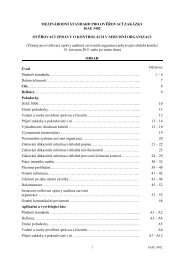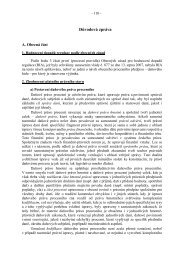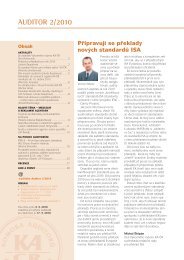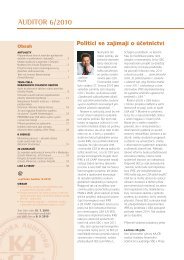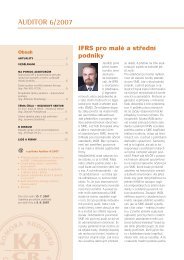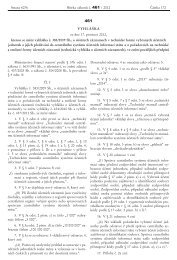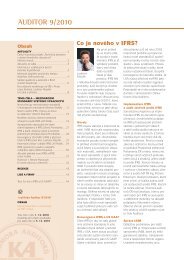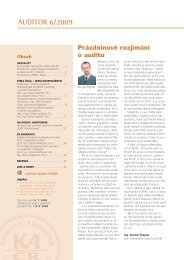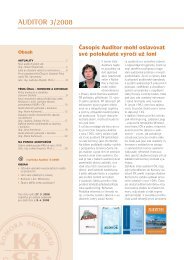Guide to Using International Standards on Auditing in - IFAC
Guide to Using International Standards on Auditing in - IFAC
Guide to Using International Standards on Auditing in - IFAC
You also want an ePaper? Increase the reach of your titles
YUMPU automatically turns print PDFs into web optimized ePapers that Google loves.
126<br />
<str<strong>on</strong>g>Guide</str<strong>on</strong>g> <str<strong>on</strong>g>to</str<strong>on</strong>g> <str<strong>on</strong>g>Us<strong>in</strong>g</str<strong>on</strong>g> <str<strong>on</strong>g>Internati<strong>on</strong>al</str<strong>on</strong>g> <str<strong>on</strong>g>Standards</str<strong>on</strong>g> <strong>on</strong> <strong>Audit<strong>in</strong>g</strong> <strong>in</strong> the Audits of Small- and Medium-Sized Entities Volume 1—Core C<strong>on</strong>cepts<br />
Examples of Effective Substantive Analytical Procedures<br />
Exhibit 10.4-4<br />
F<strong>in</strong>ancial<br />
Statement<br />
Amount<br />
Sales<br />
Amortizati<strong>on</strong><br />
Expenses<br />
Overhead Element<br />
of Inven<str<strong>on</strong>g>to</str<strong>on</strong>g>ry<br />
Payroll Expense<br />
Commissi<strong>on</strong><br />
Expense<br />
Payroll Accruals<br />
Relati<strong>on</strong>ship and Procedure<br />
Sell<strong>in</strong>g price applied <str<strong>on</strong>g>to</str<strong>on</strong>g> the quantities shipped.<br />
Amortizati<strong>on</strong> rate applied <str<strong>on</strong>g>to</str<strong>on</strong>g> capital asset balances, allow<strong>in</strong>g for effect of additi<strong>on</strong>s<br />
and disposals.<br />
Relat<strong>in</strong>g actual overheads <str<strong>on</strong>g>to</str<strong>on</strong>g> actual direct labor or producti<strong>on</strong> volumes.<br />
Pay rates applied <str<strong>on</strong>g>to</str<strong>on</strong>g> number of employees.<br />
Commissi<strong>on</strong> rate applied <str<strong>on</strong>g>to</str<strong>on</strong>g> sales.<br />
Daily payroll applied <str<strong>on</strong>g>to</str<strong>on</strong>g> number of days accrued.<br />
Other Analytical Procedures<br />
Analysis can take the form of:<br />
• Detailed comparis<strong>on</strong>s of current f<strong>in</strong>ancial statement or f<strong>in</strong>ancial data with that of prior periods or<br />
with current operat<strong>in</strong>g budgets.<br />
An <strong>in</strong>crease <strong>in</strong> accounts receivable with no corresp<strong>on</strong>d<strong>in</strong>g <strong>in</strong>crease <strong>in</strong> sales could <strong>in</strong>dicate that a<br />
problem exists <strong>in</strong> the collectability of accounts receivable. An <strong>in</strong>crease <strong>in</strong> the number of employees<br />
<strong>in</strong> a professi<strong>on</strong>al organizati<strong>on</strong> would lead the audi<str<strong>on</strong>g>to</str<strong>on</strong>g>r <str<strong>on</strong>g>to</str<strong>on</strong>g> expect an <strong>in</strong>crease <strong>in</strong> salary expense and a<br />
corresp<strong>on</strong>d<strong>in</strong>g <strong>in</strong>crease <strong>in</strong> professi<strong>on</strong>al fee revenue.<br />
• Comparative data <strong>on</strong> the various types of products sold or types of cus<str<strong>on</strong>g>to</str<strong>on</strong>g>mers.<br />
This could help expla<strong>in</strong> m<strong>on</strong>th-<str<strong>on</strong>g>to</str<strong>on</strong>g>-m<strong>on</strong>th or period-<str<strong>on</strong>g>to</str<strong>on</strong>g>-period fluctuati<strong>on</strong>s <strong>in</strong> sales.<br />
• Ratio analysis.<br />
Ratios can provide support for the current f<strong>in</strong>ancial statements (e.g., comparable <str<strong>on</strong>g>to</str<strong>on</strong>g> <strong>in</strong>dustry norms or prior<br />
periods’ results) or raise po<strong>in</strong>ts for discussi<strong>on</strong>. Certa<strong>in</strong> <strong>in</strong>stituti<strong>on</strong>s, such as banks and trade associati<strong>on</strong>s,<br />
produce f<strong>in</strong>ancial statistics <strong>on</strong> an <strong>in</strong>dustry-wide basis. Such statistics can be useful when compared <str<strong>on</strong>g>to</str<strong>on</strong>g><br />
those of an entity’s operati<strong>on</strong>, and <strong>in</strong>quiries made where differences from <strong>in</strong>dustry trends occur.<br />
• Graphs.<br />
F<strong>in</strong>ally, c<strong>on</strong>sider the use of graphs <str<strong>on</strong>g>to</str<strong>on</strong>g> portray the results of procedures. Graphs visually highlight<br />
significant differences from m<strong>on</strong>th <str<strong>on</strong>g>to</str<strong>on</strong>g> m<strong>on</strong>th or period <str<strong>on</strong>g>to</str<strong>on</strong>g> period.<br />
Use of Analytical Procedures <strong>in</strong> Form<strong>in</strong>g an Op<strong>in</strong>i<strong>on</strong><br />
Paragraph #<br />
Relevant Extracts from ISAs<br />
520.6 The audi<str<strong>on</strong>g>to</str<strong>on</strong>g>r shall design and perform analytical procedures near the end of the audit that assist<br />
the audi<str<strong>on</strong>g>to</str<strong>on</strong>g>r when form<strong>in</strong>g an overall c<strong>on</strong>clusi<strong>on</strong> as <str<strong>on</strong>g>to</str<strong>on</strong>g> whether the f<strong>in</strong>ancial statements are<br />
c<strong>on</strong>sistent with the audi<str<strong>on</strong>g>to</str<strong>on</strong>g>r’s understand<strong>in</strong>g of the entity. (Ref: Para. A17-A19)




